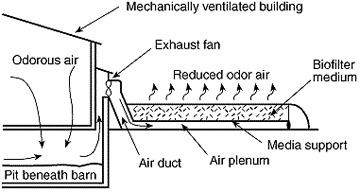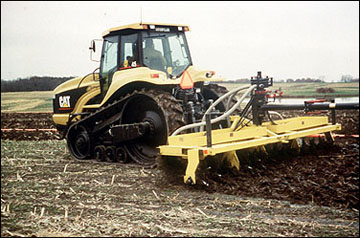Complaints about livestock odors have increased as growth in the number of large livestock operations, especially swine operations, increases the concentration of animals in small geographical areas. Many of these large operations store manure for long periods under anaerobic conditions in open manure storages or lagoons. Migration of urban residents seeking the perceived benefits of country living, such as quiet solitude and clean air, has increased the population density surrounding many livestock operations. The odor plume moving from a source tends to stay about the same width as the source and to disperse upward. Thus, the combination of large sources of odor and large populations downwind increases the likelihood that odors will affect one or more residences. Surface application of manure can result in a very wide odor plume. Liquid manure, especially, can have high concentrations of odorous compounds. Dry manure tends to emit fewer odors.

Odor complaints are more common when the humidity is high and the air is still or when the prevailing breezes carry odors toward populated areas. When the air is still, odors may flow down slopes much as water does. Surface application of relatively fresh solid manure, or a manure slurry, without immediate incorporation can cause high odor levels. Odors emanating from feedlots, manure storage ponds and undersized lagoons may lead to complaints. For this reason, site selection and control of a large land area surrounding large livestock operations to minimize close proximity of downwind neighbors are of utmost importance. Perception of nuisance odors at a given distance from a confinement facility is less common with poultry operations and most common with swine operations. In the early planning stages for such facilities, operators should check local and state regulations for separation distances required for various sizes of new or expanded confinement facilities.
Table 1 shows the buffer distances (the minimum distance between the nearest confinement building or lagoon and any public building or occupied residence) required by the Missouri Department of Natural Resources (MDNR).
Table 1. Buffer distances required by Missouri Department of Natural Resources for various classes of animal feeding operations.
| Size classification | Buffer distance in feet |
|---|---|
| Class 1A, 7,000 or more AUE* | 3,000 |
| Class 1B, 3,000 to 6,999 AUE | 2,000 |
| Class 1C, 1,000 to 2,999 AUE | 1,000 |
| *1 AUE (animal unit equivalent) equals the following: 1.0 beef feeder or slaughter animal, 0.5 horse, 0.7 dairy cow, 2.5 swine weighing over 55 pounds, 15 swine weighing less than 55 pounds, 10 sheep, 30 laying hens, 55 turkeys or 100 broiler chickens. |
Causes of common odors from livestock operations
Most objectionable odors from livestock operations are the result of volatile compounds generated during the decomposition of manure. More than 200 of these odor-generating compounds have been identified. The wide range of odorous compounds from manure adds to the complexity of odor control solutions. Commonly reported odorous compounds associated with manure and waste water are those containing sulfur (e.g., hydrogen sulfide and mercaptans), those containing nitrogen (e.g., ammonia and amines), volatile organic acids, phenols, and alcohols (Table 2). Ammonia and hydrogen sulfide are easily measured but do not necessarily correlate well with odor complaints from neighbors, although hydrogen sulfide levels from feedlots are regulated in Minnesota. Meeting ammonia emission limits might be as difficult for poultry and dairy operators as meeting hydrogen sulfide emission levels is for pork producers. Research indicates that the transport of odors is also associated with dust particles or aerosols. Therefore, controlling dust or aerosol emissions will help control odors.
Table 2. Characteristics of gases produced in decomposing manure.
| Gas | Odor | Characteristic | Exposure limits | Effects |
|---|---|---|---|---|
| Ammonia (NH3) | Sharp, pungent | Lighter than air. Results from anaerobic and aerobic activity. | 10 ppm | Irritation to eyes and nose. Asphyxiating at high levels. |
| Hydrogen sulfide (H2S) | Rotten egg smell | Heavier than air. Low odor threshold. Soluble in water | 10 ppm | Toxic: causes headache, dizziness, nausea, unconsciousness, death. |
| Methane (CH4) | Odorless | Lighter than air. Product of anaerobic activity. | 1,000 ppm | Headache, asphyxiant, explosive in 5 percent-15 percent mixture of methane with air. |
| Carbon dioxide | Odorless | Heavier than air | 5,000 ppm | Drowsiness, headache. Can be asphyxiating. |
| Volatile organic acids | Strong | High odor potential under anaerobic conditions. Low odor potential under aerobic conditions. | ||
| Phenolic | Strong | P-cresol has a lower odor threshold than hydrogen sulfide. Present in raw manure and concentrations increase under anaerobic conditions. |
Many of the odorous compounds are a result of biological reactions occurring primarily in an anaerobic environment. Many odorous compounds commonly found in fresh manure become more concentrated during anaerobic decomposition (Table 3). The increased concentration of odorous compounds in stored manure supports the observation that more objectionable odors are associated with stored manure rather than manure that is spread daily.
Table 3. Concentrations of odorous compounds in fresh and stored pig manure.
| Chemical compound | Concentration (ppm) | Increase in concentration | |
|---|---|---|---|
| Fresh slurry | Anaerobically stored manure after 24 hours | ||
| Total sulfides | 1.6 | 23.6 | 1,375 percent |
| Phenol | 5.6 | 13.5 | 141 percent |
| P-cresol | 24.9 | 31.4 | 26 percent |
| Indole | 2.1 | 5.3 | 152 percent |
| Propionic acid | 310.0 | 571.0 | 84 percent |
| Acetic acid | 1,233.0 | 1,923.0 | 56 percent |
Various cures for livestock odor problems
Buildings

- Biofilters with mats made from materials such as compost or straw greatly reduce the odor emanating from ventilating fans but should be made so that airflow will not be overly restricted (Figure 2).
- Pit fans can improve air quality inside buildings.
- Trees can aid in the upward dispersion of exhaust air from both naturally ventilated and fan-ventilated buildings and may filter air passing through the vegetation. Costs per animal are low but benefits are uncertain.
- Minimizing the surface area of slats and solid floors where manure can dry to produce dust and urine can evaporate to produce ammonia will reduce odor levels both inside and outside of buildings.
- Frequent flushing of gutters and frequent pit drawdown and recharge reduce the buildup of odorous gases.
- Many commercial pit additives are available and have been tested under different circumstances with varying results.
- Dust and accompanying odors can be reduced by using pelleted feed or adding oil/fat to rations, and by using drop tubes through lids on feeders.
- Sprinkling oil on the floor reduces dust, odor and gases in swine buildings.
- Dietary modification shows promise in reducing ammonia and sulfide production.
Manure storages
- Have the minimum design volume of water, or effluent from another lagoon, in new lagoons before adding manure. Do not exceed the design loading rate.
- Charge lagoons frequently to eliminate slug loading.
- Straw covers and plastic covers for lagoons and open manure storage tanks and ponds can reduce odor by 70 to 90 percent. Straw and chopped corn stalks work well on slurry storages; plastic is more satisfactory on lagoons.
- Mechanical aeration of lagoons can reduce odor, but initial and operating costs are so high that this cure is usually used only to correct a problem.
- Scrape manure off of open lots frequently. Storing solid manure under a roof reduces exposure of the odor source to the wind and keeps the manure dry and therefore less odorous.
- Maintaining manure pH at approximately 7 is ideal for aerobic and anaerobic biological processes.
- Composting can greatly reduce manure odors, but marketing the compost is usually required to make this control economically feasible.
- Many commercial additives advertised to reduce odors have been tested under different circumstances with varying results.
- Anaerobic digesters are estimated to reduce odors by 90 percent but have not generated sufficient energy to be economically sustainable. They have been more successful for dairy and poultry operations than for swine.
Land application of manure

- Injection or immediate incorporation of manure being land applied can reduce odor by as much as 90 percent (Figures 1 and 3).
- Application by relatively low-pressure, low-trajectory irrigation will result in less drift and vaporization than high-pressure and high-trajectory application. In-canopy sprinklers for center-pivot irrigators should be considered for odor reduction.
- Manure spread during cold weather will create fewer odors than if spread in warm weather but do not spread manure on frozen or snow covered ground where runoff may occur. Plan summer manure spreading between 8 a.m. and 2 p.m., if possible, to take advantage of natural weather assistance.
- Apply manure when the wind is not blowing toward sensitive areas and when the humidity is low, the sky is clear and temperatures are rising.
Safety
Agitation of liquid manure storages during pumping is recommended to prevent a buildup of solids and to increase the value of the nutrients applied to the land. However, agitation of pits under buildings occupied by animals or humans can be fatal because of the release of gases that are either toxic or capable of displacing the oxygen in the building. The gases of major concern are hydrogen sulfide (H2S), ammonia (NH3), carbon dioxide (CO2) and methane (CH4). Hydrogen sulfide is the most toxic of these gases. Like carbon dioxide, it is heavier than air and can displace the oxygen in the building. Methane is explosive at mixtures between 5 and 15 percent. To prevent loss of life, animals and workers should not be in the building during pit agitation.
Because of the risk of exposure to noxious gases, avoid entering a manure pit if possible. Carbon dioxide and hydrogen sulfide tend to accumulate above the liquid in the pit and may fill an empty pit. If you must enter the pit, ventilate it with fresh air before entering and wear a harness with a lifeline to outside helpers who can pull you out if you are overcome by the gases.
For further information
- BAEU-17 Odor Control for Animal Agriculture. L. Jacobson, D. Schmidt, R. Nicolai, and J. Bicudo. Biosystems and Agricultural Engineering Update. University of Minnesota Extension Service, University of Minnesota, St. Paul. 1998.